The Pixel 6 exemplifies the best of what Google services and Android 12 have to offer. So much so that I'd claim that the Pixel 6 is the most significant phone upgrade Google has made since it launched the Pixel line in 2016. The phone's new cameras, Google's Tensor chip and premium ambitions follow months of hype -- partly stemming from Google announcing the phone months before it was released -- and its bold two-tone design. All of these changes come while keeping the Pixel 6 at a midtier $599 price, which easily washes away the bad taste left by the understated Pixel 5.
Previous Pixel phones have lived in that safe, quiet and crowded midtier space where phones cost between $600 and $800. For most people, they were good and sometimes great phones but lacked the luster, specs and appeal of more premium phones from Samsung and Huawei.
Like
- Two-tone design
- Value for the price
- The main camera is Google's best
Don't Like
- Under-display fingerprint reader can be frustrating
- Battery life is good, but hard to get more than a day
- The ultrawide camera is decent but not on the same level as the main camera
So what's the problem? Well, in short, Pixel phones haven't sold well. It reminds me of the early days when Michael Jordan joined the Chicago Bulls but they weren't winning championships yet. The Pixel 6 is an attempt to build the phone up to be more successful and appealing. It's like when the Bulls decided to build a team around Jordan to help him win championships.
Instead of powering the phone with a Qualcomm Snapdragon processor, Google made its own chip, called Tensor. This allows the Pixel 6 to do computations and AI more securely and quickly on the phone than constantly using the cloud. Tensor opens up a slew of new software features Google wouldn't have been able to add using a different processor.
Google extended its three years of OS and security updates to five. In the US, the Pixel 6 is available both through Google and all major carriers. And Google even created a subscription program a la Apple's iPhone Upgrade program. It's called Pixel Pass and costs $45 a month for two years.
Even the Pixel's crown jewel -- its cameras -- got upgraded lenses and hardware that's more premium. Now that Google has improved everything in, on and around the Pixel, is it ready for its championship? (I promise that's the last Bulls reference.) In short, yes.
This is the Pixel phone I always wanted from Google. I spent over a week with the new phone and it lives up to a lot of the hype. The Pixel 6 starts at $599 (£599, AU$999) and comes with 128GB of storage. For that price, I can't think of a better phone to recommend right now.
If you're looking for an in-depth look at the Google Pixel 6 Pro, check out the review my colleague Andy Hoyle wrote.
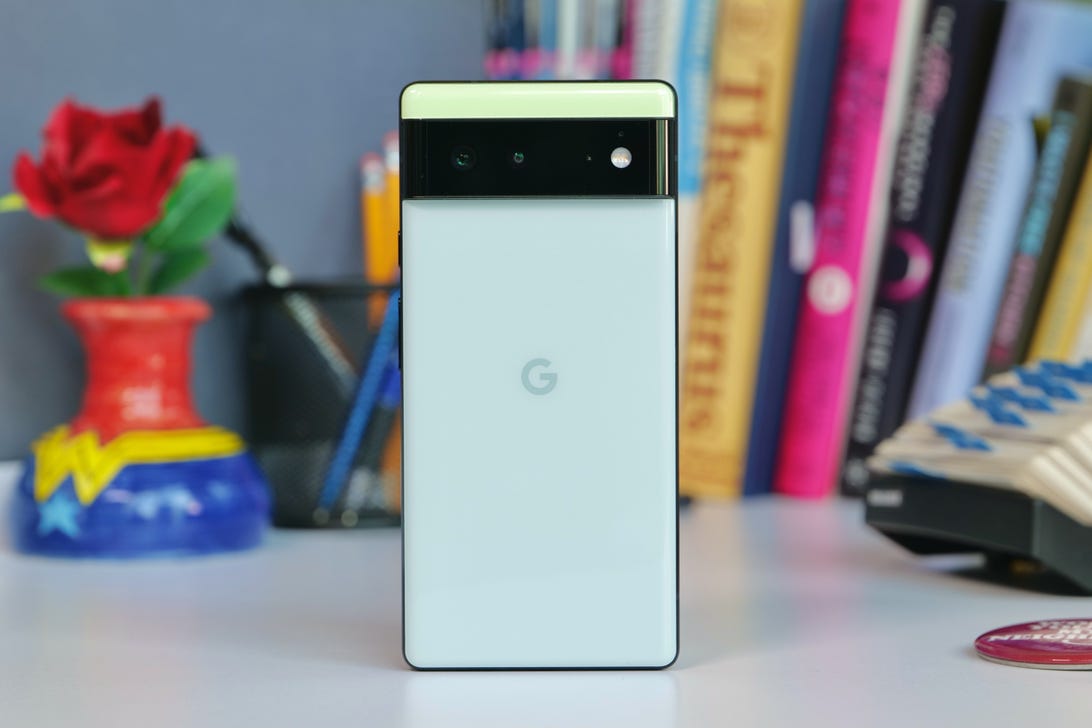
At $599, the Google Pixel 6 is one of the best phones you can buy.
Patrick Holland/CNETThe Pixel 6's bold two-tone design makes me swoon
The Pixel 6 has a 6.4-inch, 1080p screen. It can be set to automatically switch from 60Hz to 90Hz depending on the content onscreen. There's an hole-punch cutout for the selfie camera and the screen is flat with thick, Sharpie-like bezels that bleed into the matte-finish aluminum sides. For comparison's sake, it reminds me a bit of the iPhone XR and iPhone 11, which also had similar bezels and rounded sides, and that's not necessarily a bad thing.
In use the screen is pleasant. The resolution is good, but the Pixel 6 Pro's is better.
The front is covered in Gorilla Glass Victus. Under the screen is a fingerprint reader, which at first worked for me half of the time. It was frustrating and not a very good experience. After a maddening few days, I double-registered my thumbprints and it worked nearly every time. Now I don't even need to smash my finger into the screen.
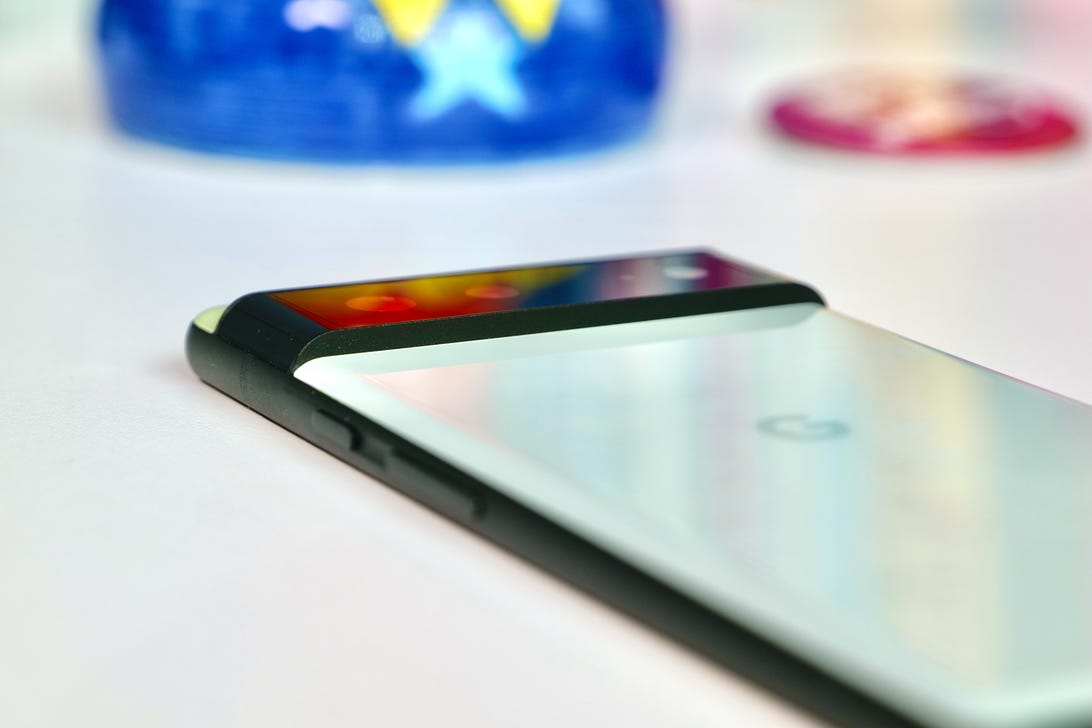
My review unit's color is called Sorta Seafoam. The back below the camera bar is light gray but depending on the light it can look light blue.
Patrick Holland/CNETThe back is where the phone's design really makes me swoon. It's made of Gorilla Glass 6 and has a two-tone color scheme. My review unit is Sorta Seafoam, which means the bottom of the back is sort of light gray or sort of light blue depending on the lighting. The top back strip is a light lime green, which contrasts nicely against the deep black of the camera bar. The overall look of the Pixel 6 reminds me a tad of the Pixel 2 XL and its panda color.
The horizontal camera bar runs across the width of the back and looks bold and different. The camera bar isn't just designed to be a Google branding element; you can put the Pixel 6 without a case on a table and it doesn't wobble.
Overall, the fit and finish are nice. If you grab a Pixel 6 Pro, which costs $300 more, you can see several small ways it feels more premium than the Pixel 6.

The camera bar houses a main wide-angle camera and an ultrawide-angle camera.
Patrick Holland/CNETThe Pixel 6 takes amazing photos
Out of all the improvements, I was most hyped to try the Pixel 6's cameras, and Google definitely delivered. The Pixel 6, with its higher-specced lenses and sensors, takes fantastic photos. Let me immediately undercut that to remind you that this is still a phone. A mirrorless camera or DSLR can consistently take better photos in a wider range of lighting and conditions. But people don't always have a mirrorless camera with them.
The Pixel 6 has two rear cameras: a main camera with a wide-angle lens and a second camera with an ultrawide-angle lens. These are the exact same wide and ultrawide cameras found on the Pixel 6 Pro. The ultrawide camera offers 0.7x magnification instead of the 0.6x magnification on the Pixel 5. Overall the ultrawide is good but not great. Details in photos are OK but often soft.
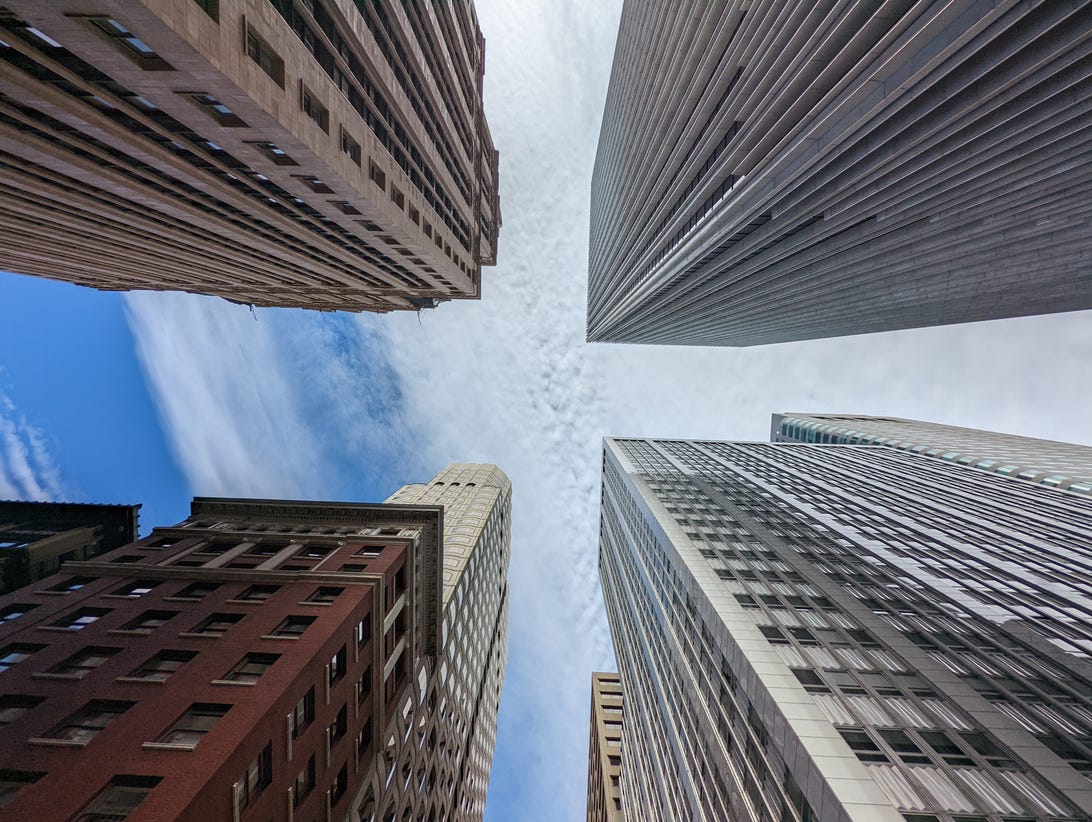
Under bright soft lighting, the ultrawide can capture some decent photos.
Patrick Holland/CNET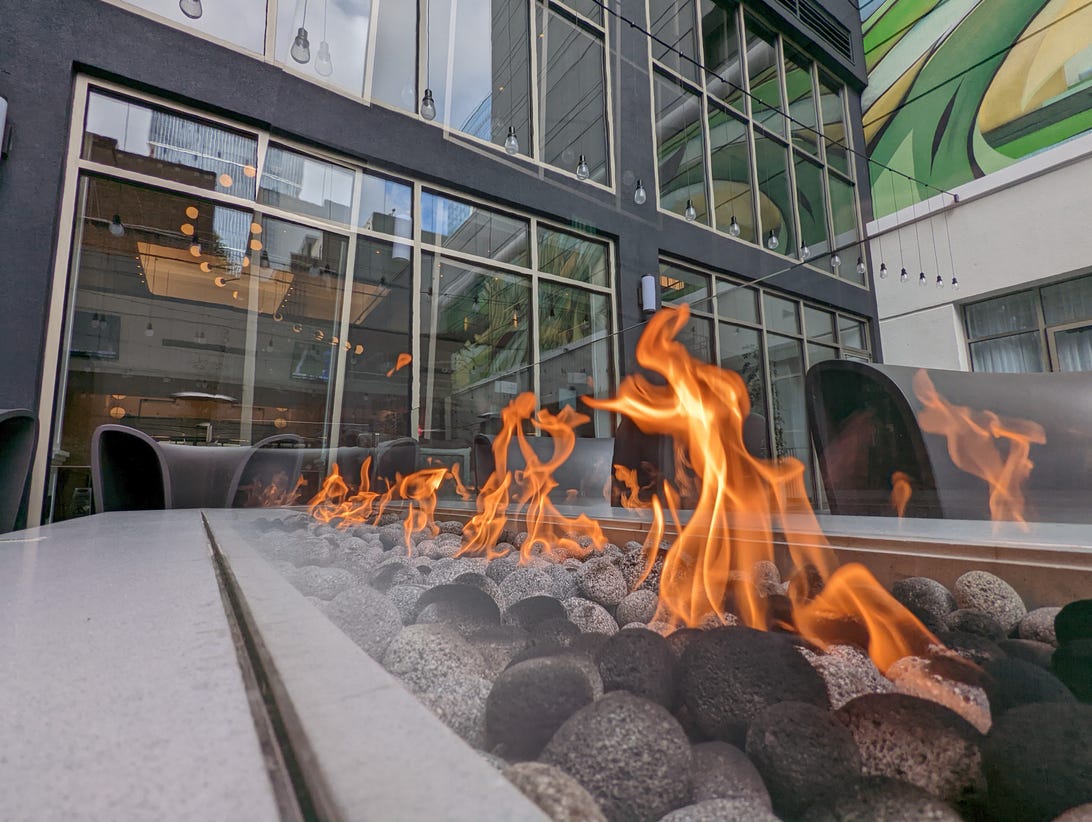
Check out the highlights in the flames.
Patrick Holland/CNET
The dynamic range is decent but limited.
Patrick Holland/CNET
In bright lighting, the ultrawide is capable of good skin tones.
Patrick Holland/CNET
In medium to low-light situations like here, the ultrawide shows its limits.
Patrick Holland/CNETThere is a noticeable step down in quality going from the main camera to the ultrawide. Take a look at the photos below that I took of the Transamerica building in San Francisco.
I wish the ultrawide camera were wider. I prefer the perspective from the ultrawide cameras on the Galaxy S21 Ultra and iPhone 13 Pro more. Check out a comparison below.
The main camera has a 50-megapixel sensor, which uses pixel binning to create 12.5-megapixel pictures. Photos from the Pixel 6 are amazing. Details are great.

The colors and clarity in this photo are excellent and accurate.
Patrick Holland/CNET
For a phone, the Pixel 6 has an excellent dynamic range.
Patrick Holland/CNET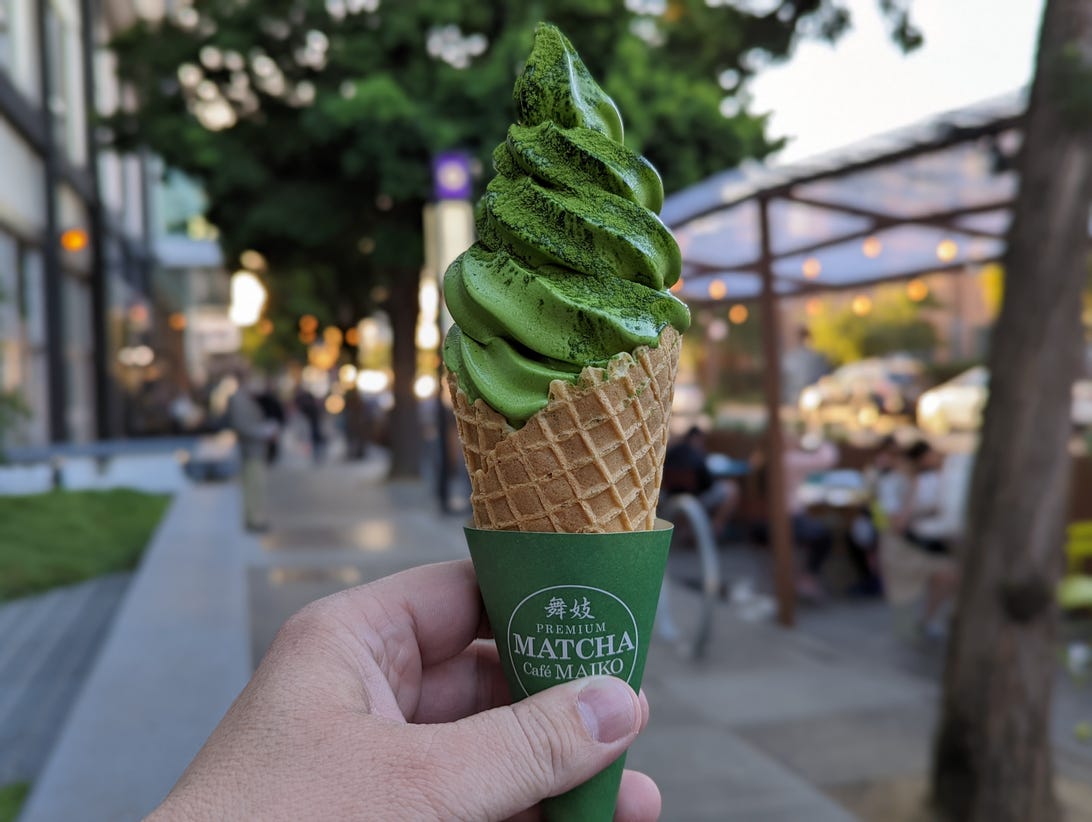
Look at the colors and detail of this matcha ice cream cone.
Patrick Holland/CNET
Another example of the Pixel handling a wide dynamic range well.
Patrick Holland/CNET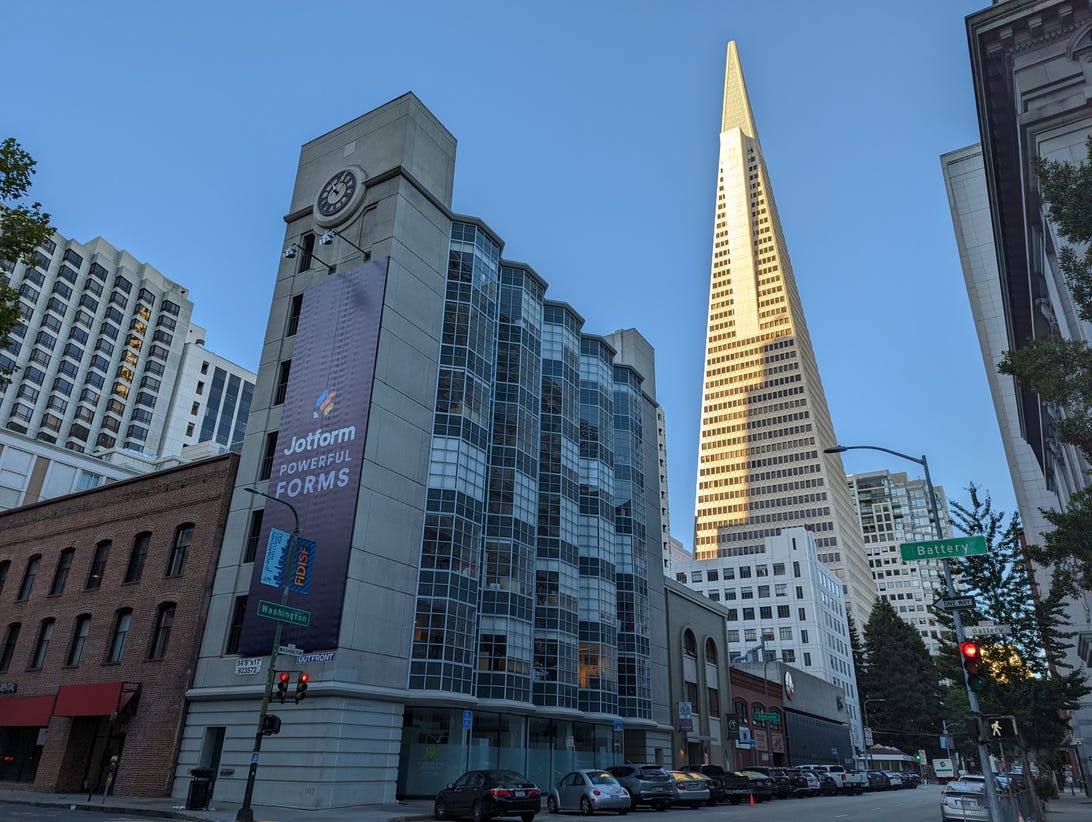
Notice the contrast of the details in direct sunlight and those in the shadows.
Patrick Holland/CNET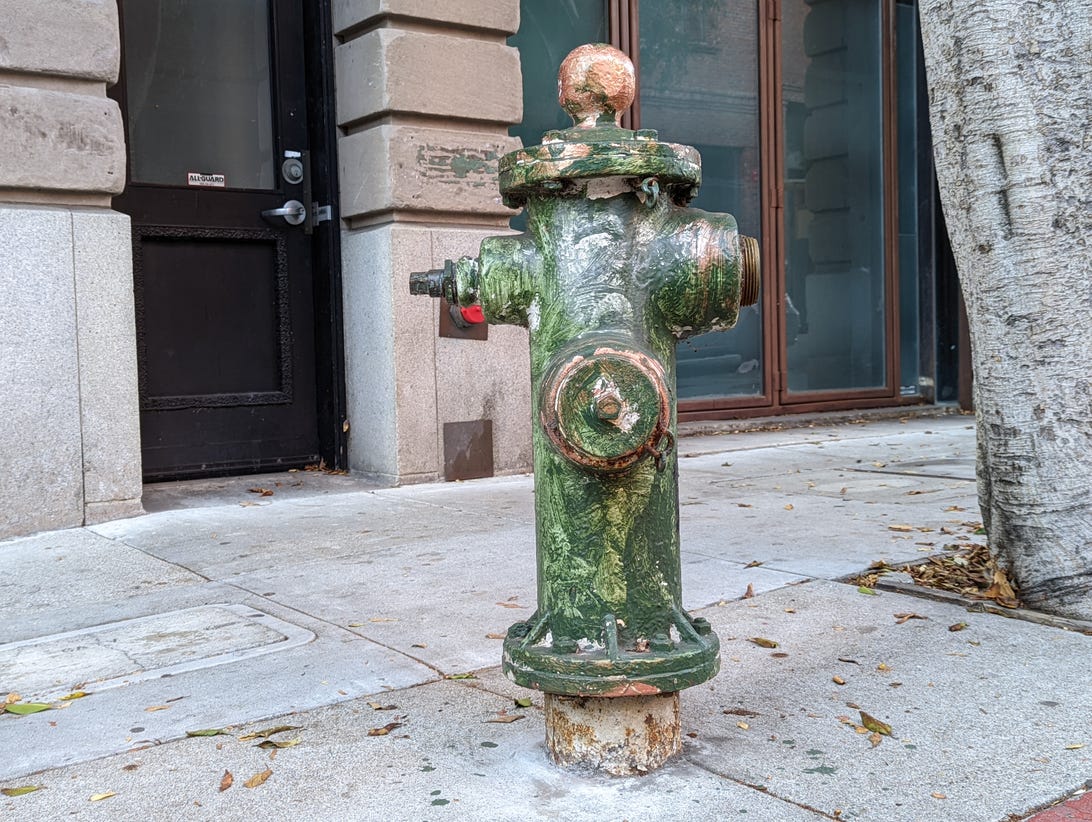
Textures look outstanding. Check out the paint brush marks on the old fire hydrant.
Patrick Holland/CNET
I like how the Pixel captured the texture of the fur on each dog.
Patrick Holland/CNET
In medium and low light, I noticed some ghosting and flaring when a light source is in the frame, like the cafe string lights here. This wasn't problematic and not nearly as bad as some other phones sold today.
Patrick Holland/CNETThere are so many Pixel 6 camera modes and tools
Google's Tensor chip allows for even more camera modes and tools. There is Night Sight, Google's version of combining multiple images together when it's too dark. It's excellent on the Pixel 6.

I like the dramatic way Night Sight renders photos.
Patrick Holland/CNET
This Night Sight photo was taken with the ultrawide camera.
Patrick Holland/CNET
In real life, this was pretty much all in shadow aside from the light and windows.
Patrick Holland/CNETThere's the new Motion mode, which has two options: Action Pan and Long Exposure. Action Pan gives the background of a photo a dramatic motion blur. It's fun. It's not going to reinvent photography but it's pretty fun to use.

Action Pan can take what might be an otherwise ordinary photo and add pizzazz.
Patrick Holland/CNETThe second Motion mode is Long Exposure, which mimics a long-exposure photo. There are apps that do something similar but I got some decent light trails from traffic and some silklike water from a fountain. Again, it's fun. It doesn't replace doing long-exposure photography on a dedicated camera.
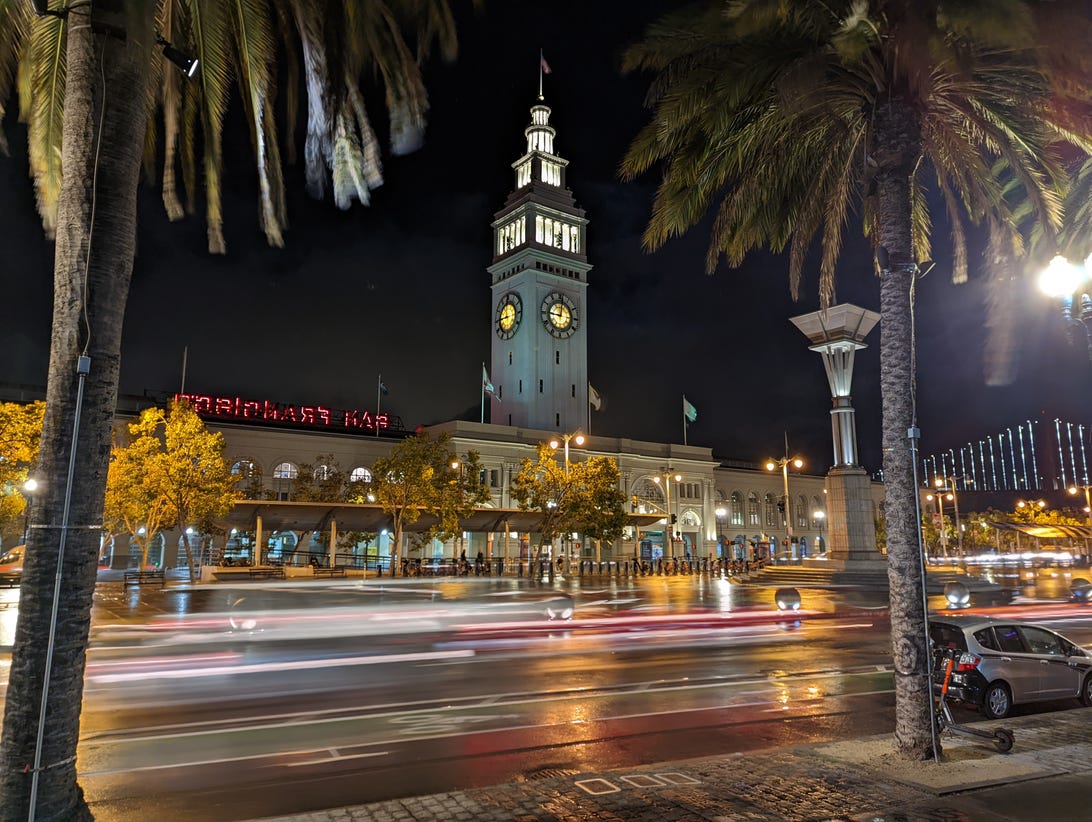
Google's Motion mode for Long Exposure works well enough. It's similar to converting a Live Photo in iOS to Long Exposure.
Patrick Holland/CNETBut that's not all. Google gives you a neat tool called Magic Eraser. It lets you pick an object, a person or a part of a photo to remove. You can get to this tool in one of two ways. In Photos, you'll see a suggestion about removing people in the background. Or when you go to edit, tap on Tools to reveal the feature.
Magic Eraser finds and identify the silhouettes of people in the background. You can also use your finger to paint out the part you want gone. Overall it works well, but it's far from perfect. Sometimes I got absolutely amazing results like removing people from the photo below of a pedestrian walkway -- though on closer inspection, you can see the blurry patches where parts of the photo were removed.
Other times, like in the photo below, there were transition artifacts. It removed two people in the background here, but also disfigured the hand of the lady to the right.
There are so many more camera features that I wasn't able to highlight in this review, like Face UnBlur. But CNET will have an even more in-depth look at the Pixel 6 cameras soon.
The Pixel 6 camera treats complexions more equitably
One improvement Google talked about was Real Tone, which was a major rethink and exploration about how photos, specifically Google's algorithms and engineers, handle people with different complexions. I still want to explore this feature more, but the photos I took of friends, co-workers and other people with darker complexions look good, even if they're not under the most flattering light. Often when I showed someone a photo I took with the Pixel 6, even if it's them doing a mundane thing, they asked for a copy.

This is one of my favorite photos I took with the Pixel 6.
Patrick Holland/CNET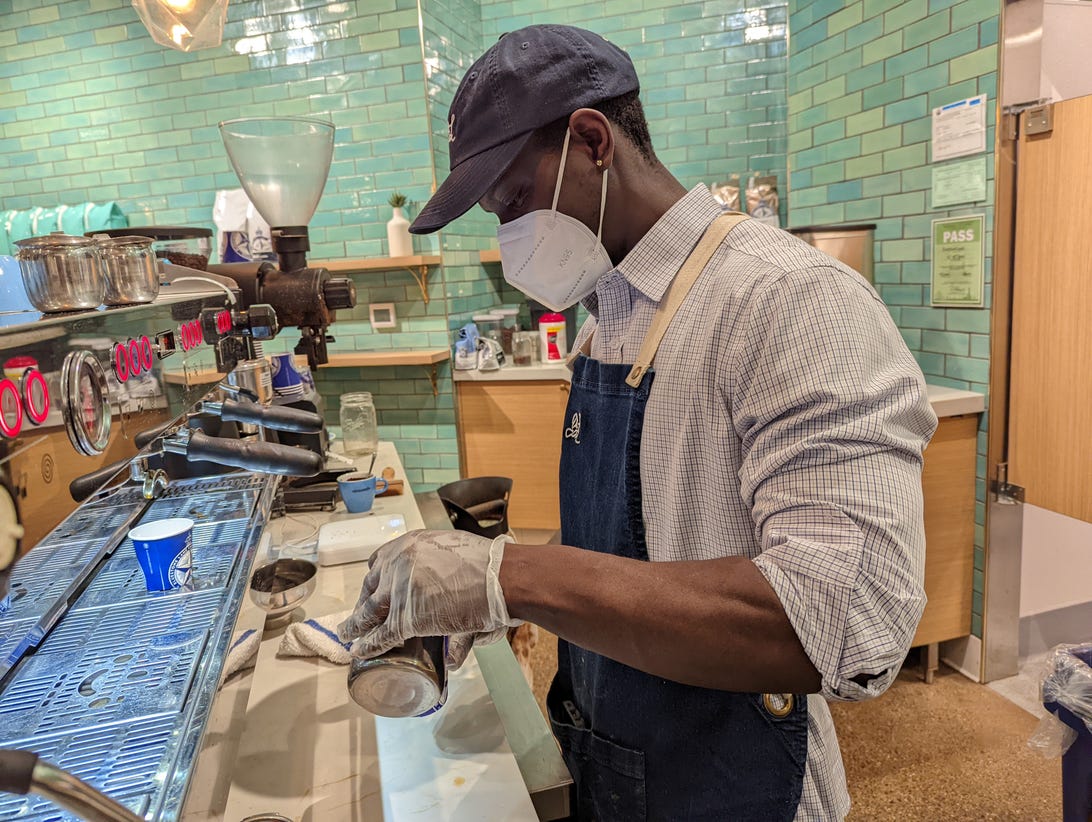
Even under harsh fluorescent lighting, Laban's skin looks good.
Patrick Holland/CNET
This was taken in a very dim restaurant. The Pixel raised the overall brightness but protected the color, tone and details of the skin.
Patrick Holland/CNETBelow is a photo taken with harsh backlight. Admittedly, this isn't a great way to take a photo, but I wanted to see what would happen. Google said the Pixel 6 handles stray light better. See how it did against a photo taken with the iPhone 13 below.
The differences between the two photos aren't drastic, but Eric, who is the subject, preferred the photo from the Pixel 6. He liked how it handled the color and highlights in his skin. You can really notice this in his arms.
Videos from the Pixel 6 are better and selfies are just OK
The Pixel 6 records the best video from any Pixel phone. Details and color accuracy are better. In terms of comparing the image quality between photos and videos, there is a smaller difference than there has been on prior Pixels. Don't get me wrong, photos are still the strength of the Pixel.
When recording video in medium and low light, image noise is pretty apparent. Also, the improvements Real Tone brings to photos are unmatched with how videos handle different complexions. Take a look below at some sample videos I recorded with the Pixel 6.
On the front, the Pixel 6 has an 8-megapixel camera that shoots 1,080p video. The Pro has a wider selfie camera that can record 4K. Selfies photos from the Pixel 6 are good but in medium and low light start to look noisy.

Here is a Portrait mode selfie from the Pixel 6.
Patrick Holland/CNET
My colleague Lexy took this low-light selfie. The quality is OK, but overall there is a touch of motion blur.
Lexy Savvides/CNETThe Pixel 6 is defined by Google's Tensor chip
The Pixel 6 doesn't run on the Qualcomm Snapdragon 888 chip found in nearly every other flagship Android phone like the Galaxy S21 and OnePlus 9 Pro. Instead, it runs on Google's Tensor processor. It's the first chip Google has made and was specifically designed by Google for the Pixel. I found the Tensor chip and the 8GB of RAM made the phone peppy to use. Opening the camera app is fast, app animations look smooth and it handles games well.
In terms of performance benchmark tests, the Tensor chip doesn't set any new records. In fact it's largely on par with the Snapdragon 888 and that's OK. The advantages Tensor brings are its security and on-device machine learning and AI.
GEEKBENCH V.5.0 SINGLE-CORE
Google Pixel 6
Google Pixel 5
Samsung Galaxy S21
Apple iPhone 13
Note:
Longer bars indicate better performanceGEEKBENCH V.5.0 MULTICORE
Google Pixel 6
Google Pixel 5
Samsung Galaxy S21
Apple iPhone 13
Note:
Longer bars indicate better performance3DMARK SLINGSHOT UNLIMITED
Google Pixel 6
Google Pixel 5
Samsung Galaxy S21
Apple iPhone 13
Note:
Longer bars indicate better performanceGoogle quotes a day on a fully charged battery and in regular use I'd say that is accurate. But in heavy use, like shooting lots of photos and videos, it had a battery life of more like three-quarters of a day. During the 10 days I tested the phone, the Pixel 6 averaged a screen-on time of 6 hours, which is good, but not great.
Android 12 is solid on the Pixel 6
The Pixel 6 runs Android 12 and it's probably the most underrated aspect of the phone. Android 12 is a delight to use. I like the big obvious buttons and sliders. The overall look of Android 12 is welcoming and prioritizes clarity over animations. I like that its system colors can match and complement my phone's wallpaper.
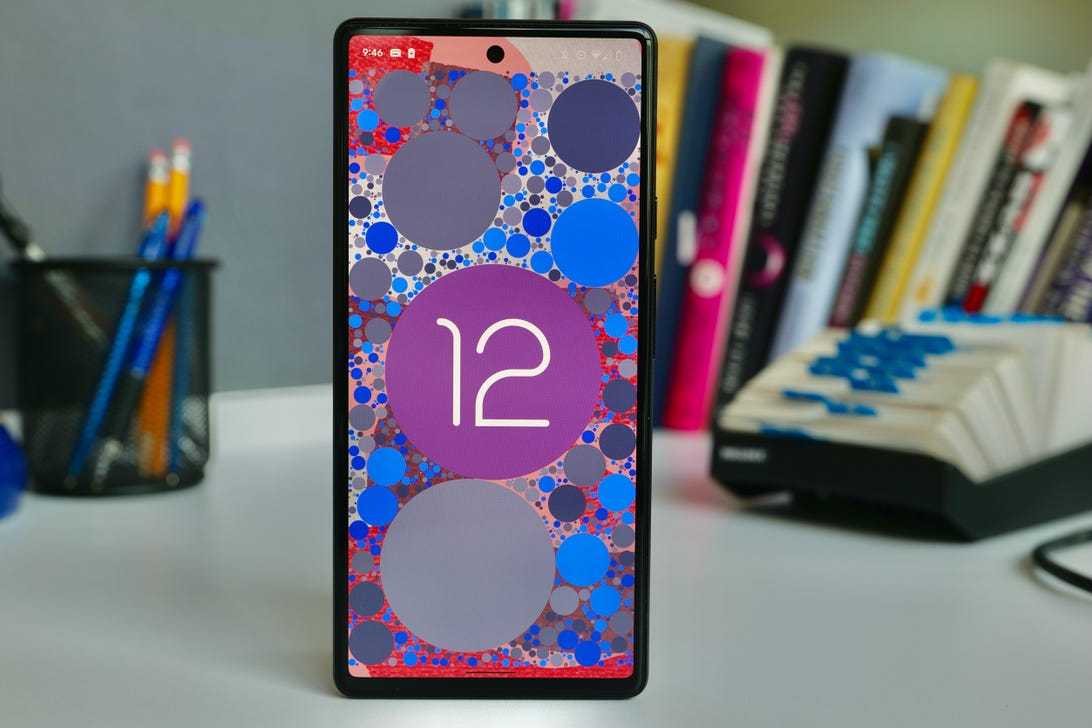
The Pixel 6 runs Android 12 and even has a handful of special features.
Patrick Holland/CNETAndroid 12 combined with the Tensor processor provides a number of welcomed privacy and security upgrades. The Pixel 6 comes with several of its own Android 12 special features, some of which are powered by Tensor. A standout for me is voice recognition. I found there to be a lot of improvement with translation, especially when I had a conversation with a Portuguese speaker. Translations were fast and accurate. For voice typing in particular, it seems to understand context better and punctuate more accurately and it's easier to command it and clear mistakes.
I tested the Pixel 6 on Google Fi, T-Mobile and Verizon here in San Francisco. The Pixel 6 supports sub-6 5G. There are special carrier versions of the Pixel 6 that also support mmWave 5G and start at $699 instead of $599.
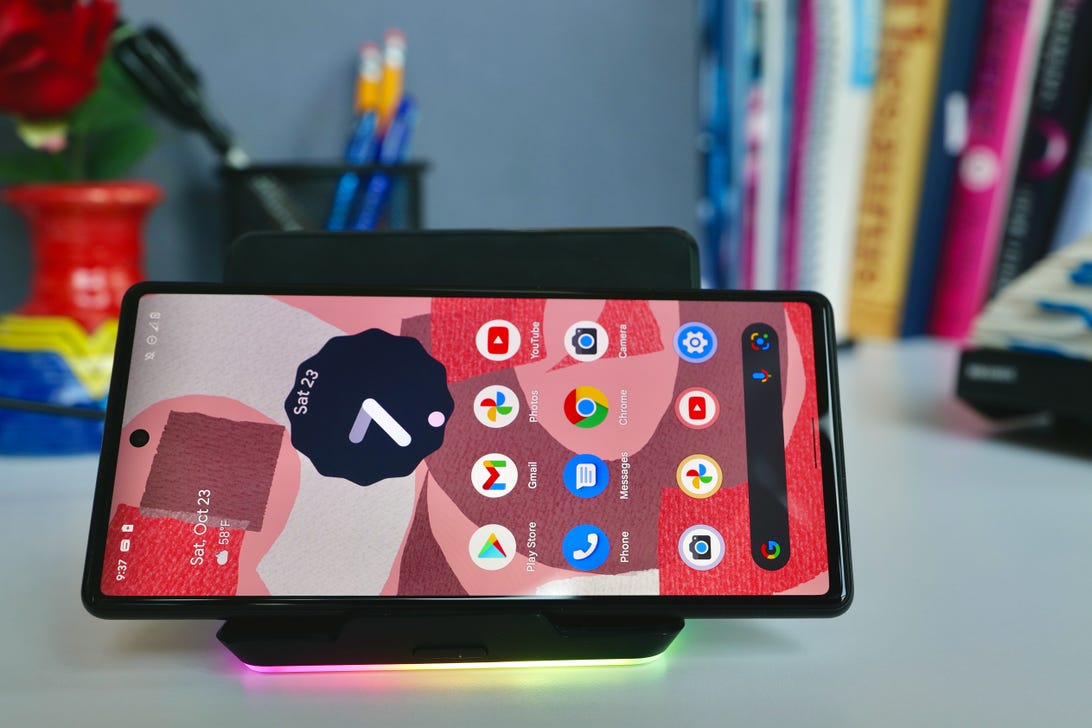
The Pixel 6 has 30W fast-charging over USB-C and supports wireless charging, as pictured above.
Patrick Holland/CNETGoogle improved the Pixel 6 in many ways
With all of the upgrades to software and hardware, you have to wonder if that will be enough to make the Pixel 6 successful. And that's really the only thing I can't answer. I can say this is the best phone Google has ever built. As tempting as the Pixel 6 is, for $300 more you can upgrade to the slightly more premium Pixel 6 Pro, which adds a telephoto camera; a 6.7-inch display with curved edges, a higher resolution and high refresh rate; more RAM; an ultrawideband chip and Gorilla Glass Victus on the back. But if you have $600 and are looking for a new phone, the Pixel 6 is my recommendation.
Google Pixel 6 specs vs. Google Pixel 6 Pro, Google Pixel 5, Apple iPhone 13
| Google Pixel 6 | Google Pixel 6 Pro | Google Pixel 5 | Apple iPhone 13 | |
|---|---|---|---|---|
| Display size, resolution | 6.4-inch OLED; 2,400x1,080 pixels; 60Hz or 90Hz | 6.7-inch LTPO OLED; 3,120x1,440 pixels; 10-120Hz | 6-inch FHD+ OLED; 2,340x1,080 pixels | 6.1-inch OLED; 2,532x1,170 pixels |
| Pixel density | 411 ppi | 512 ppi | 432 ppi | 460 ppi |
| Dimensions (inches) | 6.2x2.9x0.4 in | 6.5x3x0.4 in | 5.7x2.8x0.3 in | 5.78x2.82x0.3 in |
| Dimensions (millimeters) | 158.6x74.8x8.9mm | 163.9x75.9x8.9mm | 144.7x70.4x8mm | 147x72x7.65mm |
| Weight (ounces, grams) | 7.3 oz; 207g | 7.41 oz; 210g | 5.33 oz; 151g | 6.14 oz; 174g |
| Mobile software | Android 12 | Android 12 | Android 11 | iOS 15 |
| Camera | 50-megapixel (wide), 12-megapixel ultrawide | 50-megapixel (wide), 12-megapixel (ultrawide), 48-megapixel (telephoto) | 12.2-megapixel (standard), 16-megapixel (ultrawide) | 12-megapixel (wide), 12-megapixel (ultrawide) |
| Front-facing camera | 8-megapixel | 11-megapixel | 8-megapixel | 12-megapixel |
| Video capture | 4K 30, 60fps (rear), 1,080p 30fps (front) | 4K 30, 60fps (rear), 4K 30fps (front) | 4K | HDR video recording with Dolby Vision up to 4K at 60fps |
| Processor | Google Tensor | Google Tensor | Qualcomm Snapdragon 765G | Apple A15 Bionic |
| Storage | 128GB, 256GB | 128GB, 256GB, 512GB | 128GB | 128GB, 256GB, 512GB |
| RAM | 8GB | 12GB | 8GB | Undisclosed |
| Expandable storage | No | No | No | No |
| Battery | 4,614 mAh | 5,003 mAh | 4,000 mAh | Undisclosed; Apple lists 19 hours of video playback |
| Fingerprint sensor | Under display | Under display | Rear | No (Face ID) |
| Connector | USB-C | USB-C | USB-C | Lightning |
| Headphone jack | No | No | No | No |
| Special features | 5G sub-6 (some carrier models also have 5G mmWave) support, Wi-Fi 6E, 30W fast-charging, wireless charging, Magic Eraser, Motion mode, Real Tone, Face Unblur, Cinematic Pan, 5 years OS security updates, IP68 rating for dust and water resistance, Gorilla Glass Victus (front), Gorilla Glass 6 (back), dual-SIM capabilities (nano-SIM and e-SIM) | 5G sub-6 and mmWave support, Wi-Fi 6E, Ultra-wideband, 30W fast-charging, wireless charging, Magic Eraser, Motion mode, Real Tone, Face Unblur, Cinematic Pan, 5 years OS security updates, IP68 rating for dust- and water-resistance, Gorilla Glass Victus (front and back), dual-SIM capabilities (nano-SIM and e-SIM) | 5G enabled; water-resistant (IP68); 90Hz-refresh-rate display; dual-SIM capabilities (nano-SIM and e-SIM); reverse wireless charging; fast-charging | 5G enabled; MagSafe; water-resistant (IP68); wireless charging; dual-SIM capabilities (nano-SIM and e-SIM) |
| Price off-contract (USD) | $599 (128GB) | $899 (128GB) | $699 | $799 (128GB), $899 (256GB), $1,099 (512GB) |
| Price (GBP) | £599 (128GB) | £849 (128GB) | £599 | £779 (128GB), £879 (256GB), £1,079 (512GB) |
| Price (AUD) | AU$999 (128GB) | AU$1,299 (128GB) | AU$999 | AU$1,349 (128GB), AU$1,519 (256GB), AU$1,869 (512GB) |
"Review" - Google News
October 30, 2021 at 01:29AM
https://ift.tt/3vVoChY
Pixel 6 review: Google's most significant phone upgrade - CNET
"Review" - Google News
https://ift.tt/2YqLwiz
https://ift.tt/3c9nRHD
Bagikan Berita Ini














0 Response to "Pixel 6 review: Google's most significant phone upgrade - CNET"
Post a Comment